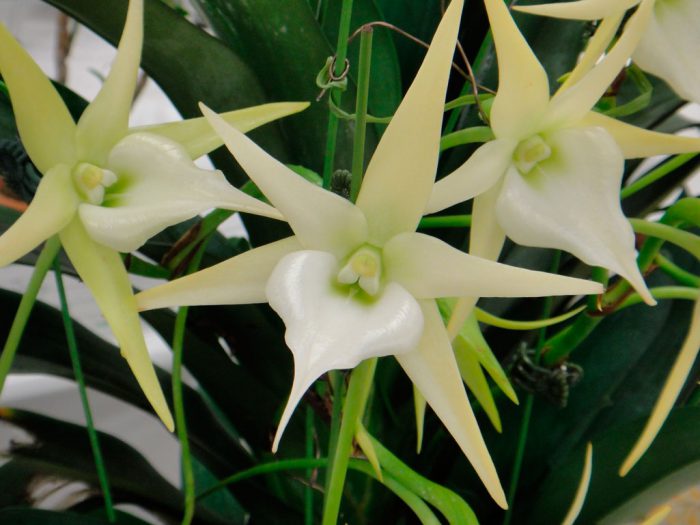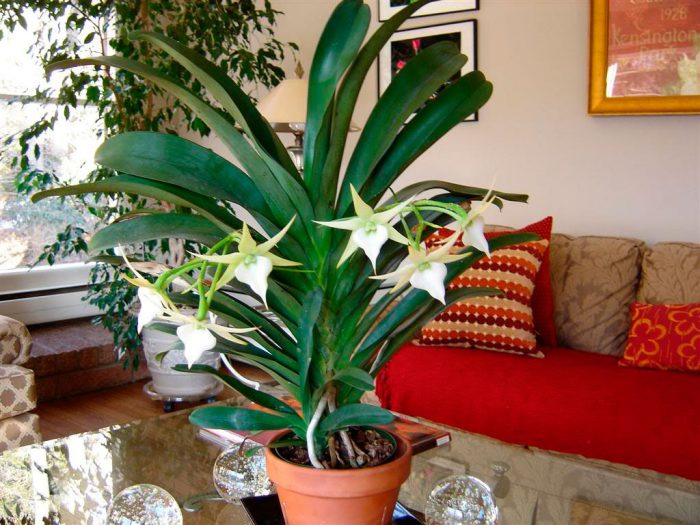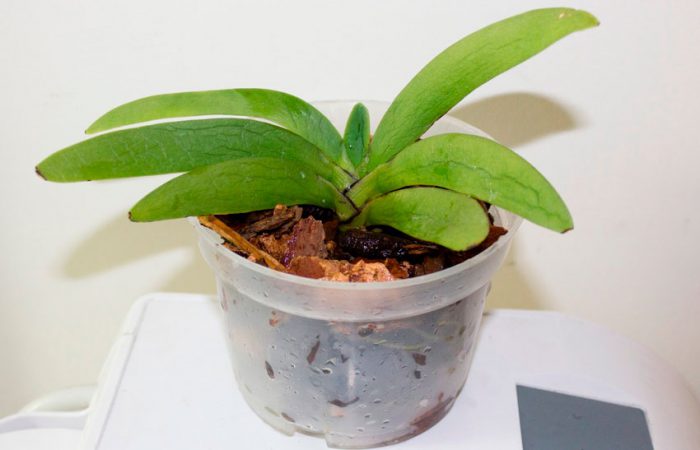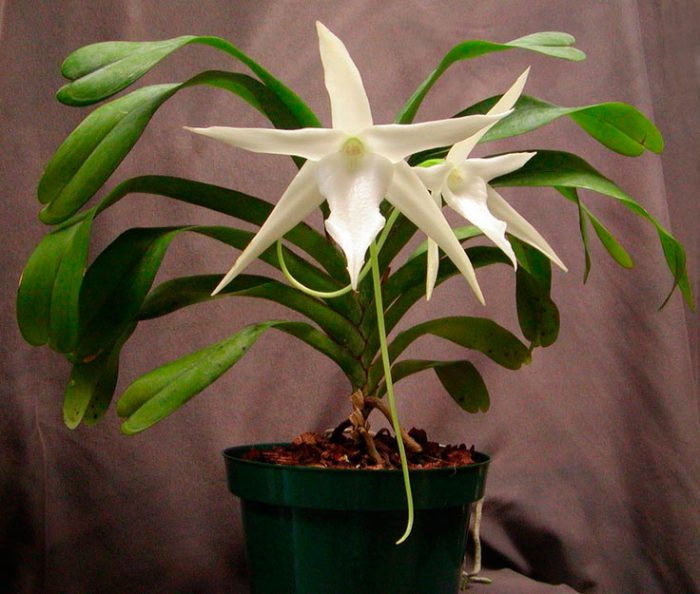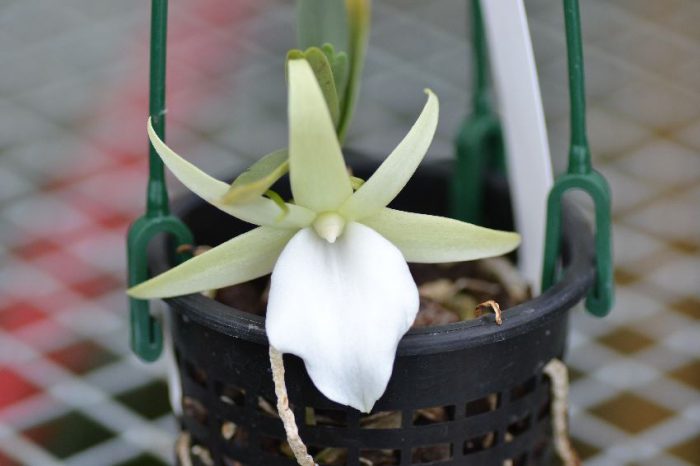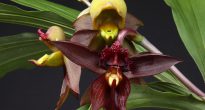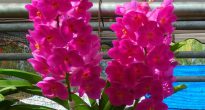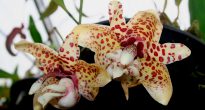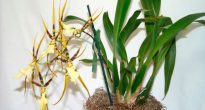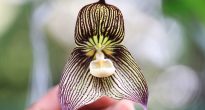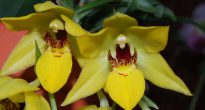Among the numerous and different members of the orchid family, the orchid called Angraecum stands out. This genus includes about 200 different species. Under natural conditions, they can be found in the tropical rainforests of Africa, on the island of Madagascar, as well as on other islands of the Indian Ocean. Star-shaped flowers are usually white. They can also be small or rather large (diameter from 3 to 10 centimeters), as, for example, among the most popular species - Angrekum Magdalena and Angrekum one and a half feet. There is a special waxy coating on the surface of the leaves and flowers, which makes this plant especially attractive. So, a flowering Angrekum bush is a very spectacular and unique sight.
Content
Caring for the Angrekum orchid at home
Such a plant, like almost all other representatives of this family, needs high humidity and sufficient heat.
Temperature regime
So, in the summer, Angrekum needs a moderate temperature of 20 to 25 degrees. With the onset of the winter period, it is recommended to slightly lower the temperature of the content by 4 or 5 degrees, but do not forget that in the room where such an orchid is located, it should not be colder than 16 degrees. It must be moistened from a sprayer and watered systematically, while ensuring that the soil mixture is slightly damp all the time. For irrigation, you should use water at room temperature, while it is best to take rainwater or well-settled, but you can also use boiled water. In order to reduce the evaporation of moisture from the substrate, it is recommended to place a not very thick layer of sphagnum on its surface. It will also help keep the soil breathable.
Illumination
The light level is very important for the normal growth and development of Angrekum. The lighting should be very bright, but the plant requires extremely diffused light. The fact is that the direct rays of the sun have a detrimental effect on the plant, which in the wild hides from them under the canopy of the forest. In addition to bright lighting, you need to provide such a flower with a fairly long daylight hours, equal to 12 hours, and it should have such a length all year round. In this regard, in the warm season, experts advise transferring Angrekum to the balcony or to the garden.This will not only help provide it with the right level of light, but the plant will also be able to receive an influx of fresh air, which has a positive effect on it. In winter, experts advise to supplement the plant with the help of special fluorescent lamps.
Earth mix
For planting, a standard soil mixture for epiphytes is suitable. For the plant to grow and bloom well, the substrate should consist of tree bark, charcoal, fern roots and sphagnum.
Flowering features
Budding begins in November, and flowering usually lasts from December to February. The flowering period is 3 to 4 weeks. The flowers of this plant are very fragrant, but this pleasant smell can be felt only at night. The fact is that insects that pollinate this type of orchid in natural conditions fly only at night, and the plant tries to attract it, enhancing its aroma at this particular time of day.
Dormant period
No clearly defined rest period is observed. However, after the flowering is over, it is recommended to carefully cut the peduncle, reduce watering somewhat, and also stop fertilizing the soil (for several months).
Fertilizer
You need to feed the plant during intensive growth. For this, it is recommended to use a complex mineral fertilizer for orchids, while taking only ½ part of the dose that is indicated on the package.
Transplant features
The transplant is carried out 1 time in 2 or 3 years. Its purpose is not only to replace the soil mixture with a fresh one, but also to change the pot to a more spacious one. It is recommended to transplant this orchid in the spring after it has faded. During the transplant, you can also carry out the reproduction procedure.
Reproduction methods
For the propagation of such a plant, "babies" (lateral processes) are used. They will definitely appear if the plant is properly cared for. You need to plant the baby very carefully so as not to damage its rather delicate roots. Otherwise, the adaptation period will be greatly delayed, and flowering can be seen only after a few years.
Diseases and pests
This genus of orchids is quite resistant to disease. Most often, young, not strong plants are sick. As a rule, a scale insect settles on them or gray rot appears. If pests are found, they should be tried to be removed from the surface of the plant, and then treated with an insecticide of the appropriate action. When rot appears, it is necessary to reduce the frequency of watering for a while. If adult specimens are properly cared for and provided with the necessary conditions for normal growth, then, as a rule, such problems do not arise with them.
Possible difficulties
Most often, flower growers are worried that angrecum does not bloom. As a rule, too dry air or irregular watering is to blame for this. If there are such problems, then it is very easy to find out about them by the appearance of the plant. So, its leaves will begin to turn yellow, and growth will become slower. In the case when an outwardly healthy plant does not bloom, this may mean that it simply does not have enough light.
Angrekum does not differ in exacting care. For its normal growth and development, only high humidity, fresh air and sufficient lighting are required.

